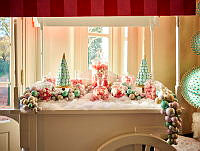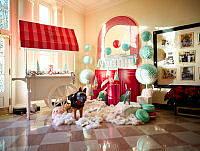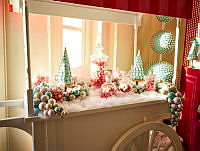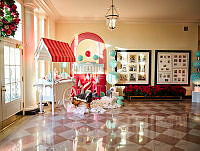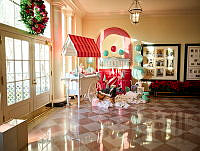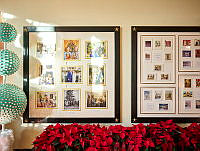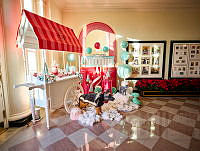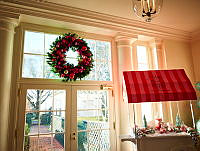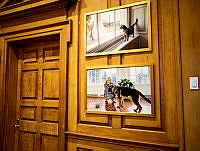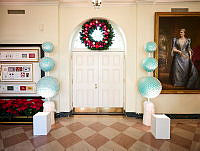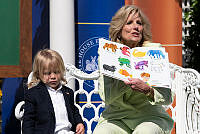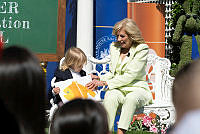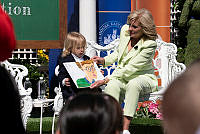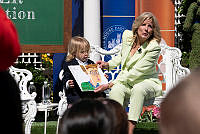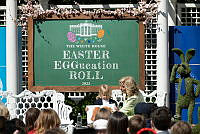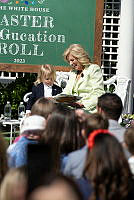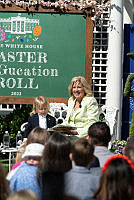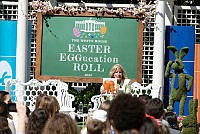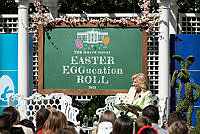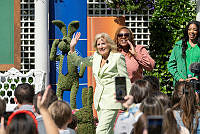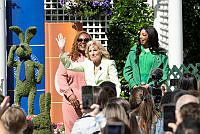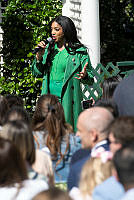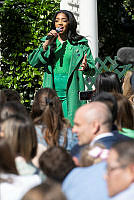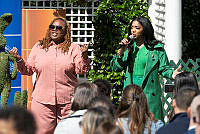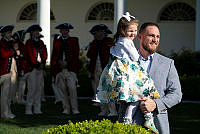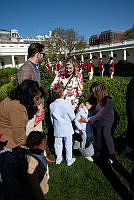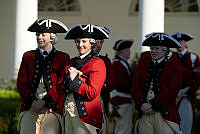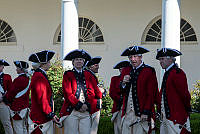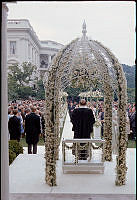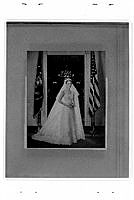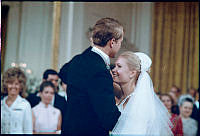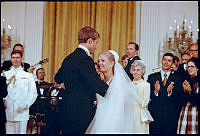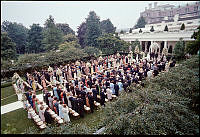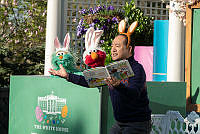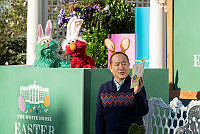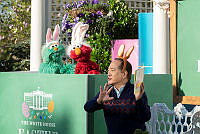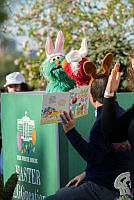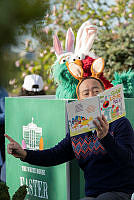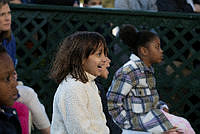White House Brides and Envisioned Flowers
Two Nineteenth-Century White House Weddings
Copyright © White House Historical Association. All rights reserved under international copyright conventions. No part of this article may be reproduced or utilized in any form or by any means, electronic or mechanical, including photocopying, recording, or by any information storage and retrieval system, without permission in writing from the publisher. Requests for reprint permissions should be addressed to books@whha.org
The first really grand White House wedding was Nellie Grant’s. For this President and Mrs. Ulysses S. Grant had the East Room redecorated entirely, adding to James Hoban’s original architectural detailing matching columns and extending the cornice into beams, all gleaming white, with accents in gold leaf. Andrew Jackson’s three chandeliers were replaced by much grander “French” models, boasting thousands of glass pieces showered over a nickel-plated framework, with gas flames shaded by cut and frosted glass shades.
Like all great events, this one had its problems and tensions. The president and his wife were hesitant about the upcoming marriage, Nellie being only nineteen, headstrong and spoiled, and the prospective groom, Algernon Sartoris, perhaps less than an ideal son-in-law. Being English, he would take Nellie far away; he was a bit idle and for all his good breeding, somewhat inclined, they feared, toward the stage. The White House had been in mourning in the spring for Millard Fillmore. The death of a president called for thirty days of official mourning. Where at most locations, flags at half staff was sufficient, at the White House chandeliers and mirrors had to be draped in black crape, with crape on the front door and around the windows. This was torn away as soon as possible so that the various decorating establishments could return and complete their work for Nellie.
By May 21, 1874, the house was put in final preparation. In the upstairs rooms the presents were displayed (according to the stores where they were bought), the state parlors were set up for light breakfast, and the State Dining Room fixed for a seated breakfast, the table massed with pink and white roses and azaleas. In the East Room a platform was built before the broad east window, over which the curtains were shut. A bell made of pink roses was suspended above, and along the walls palms and arrangements of roses stood in lines. In recalling the decorations, one of the doormen, Tommy Pendel, was not specific about flowers but captured the scene: “There was a beautiful marriage bell suspended over her [the bride’s] head. The four large columns supporting the girders were all entwined with the beautiful national colors. Palms and other plants were artistically placed around the room, the windows were closed and the room brilliantly lighted. The effect was beautiful in the extreme.”
White orchids and orange blossoms from the conservatory formed a crown to hold Nellie’s rose-point lace veil. The wedding dress itself was white satin, falling into a six-foot train. The bride carried a bouquet of roses fixed to a pearl fan, a gift from her parents. The groom gave her a bouquet of rare flowers, of what sort unrecorded, but a point was made that they came from Manhattan’s finest florist. Army and navy officers in dress uniforms stood at attention in a double row down the Cross Hall to the East Room altar. Nellie and her eight bridesmaids all in white, descended the Grand Staircase. Two hundred and fifty guests witnessed the spectacle, which for many years would be remembered as the most elaborate occasion at the White House.
Yet a mere twelve years later floral art reached another high point in the decorations for the marriage of President Grover Cleveland to Frances Folsom on June 2, 1886. The bride was not yet 22, and the groom 49. For a year the romance of the president and his former ward, the daughter of his late business partner, had captivated the American public. Frances Folsom, known popularly as “Frankie,” had become the first celebrity first lady overnight. To the president’s great disapproval, she was a staple feature on the front pages of every major paper in the United States.
When the fifty wedding invitations went out, two weeks before the event, they bore the full names of both the president and his bride. The floral decorations did not suggest so small an event. It might be assumed that Frances Cleveland’s mother Mrs. Oscar Folsom and the president’s sister Rose Cleveland ordered the decorations, but Cleveland himself kept a heavy thumb on all wedding plans and this president dearly loved the conservatories and their floral stock. The head gardener at the White House was Henry Pfister of Cincinnati, whom President Rutherford B. Hayes had appointed nearly a decade before and who had transformed the greenhouses from what one might find in a private house to a series of botanical conservatories filled with remarkable specimen plants and flowers. Cleveland had given him full support.
For the wedding the conservatories were literally extended into the State Rooms. The East Room was banked in palms, set in porcelain jardinières. It being summer, the fireplaces were closed and their hearths and mantels massed with flowers. In the Cross Hall the columns were entwined with garlands of greenery and smilax and adorned by large Union shields made of red, white, and blue roses, carnations, and immortelles. The Red and Green Rooms were similarly decorated, leaving just about enough room for guests, but the Blue Room, where the ceremony took place, had the most splendid flowers. The hearth blazed with red begonias symbolizing fire, with a border of centaureas to symbolize ashes; over the mantel a confection of pansies formed the initials “C” and “F.” The gas chandelier was decorated with roses and smilax. Palms surrounded the walls.
The wedding supper was held seated, in the State Dining Room. On the white damask cover of the long table an ocean of flowers swelled up from the Monroe plateau and upon it, sheets to the wind, a floral ship, the Hymen, sailed toward Victorian bliss. While the photographers and newspaper artists gave us fairly good records of this splendor, together with the documentary materials Henry Pfister preserved in the National Archives, one longs for color.
With this in mind, White House History brought a sheaf of the photographs and papers to me in my studio at the Torpedo Factory across the river in Alexandria and asked me to select flowers to paint from the pictures and records. The accompanying watercolors are the result.
John Adams, or at least his wife Abigail Adams, just may have been host to the first White House wedding. It is hinted in a letter from Mrs. Adams to her sister Mary from the White House, January 15, 1801, that her lady’s maid, who was Betsy Howard, and Betsy’s “lover,” were married Sunday evening the week before, presumably at the White House.2 Betsy Howard had been one of three who worked for Mrs. Adams at the President’s House in Philadelphia. She was ill at one point, but did join the first lady in Washington. Abigail Adams spoke affectionately of Betsy in her letters.
James Monroe’s daughter Maria Hester Monroe married her first cousin (nephew of her mother) Samuel L. Gouverneur on March 9, 1820, at the White House. There were forty-two guests, and Washington people not invited were vocal in their annoyance. The Monroes considered the marriage a private family affair. Sam Gouverneur was from New York and served as postmaster there, appointed through the intervention of President Monroe.
John Quincy Adams’s second son John Adams II was married in the Blue Room on February 25, 1828, to Mary Catherine Hellen, one of three sisters who lived with the Adams family in the White House. Young Adams was not much like his scholarly, bookish relatives. He was expelled from Harvard for inciting a student riot and was skilled at fist fighting.
Andrew Jackson, on April 10, 1832, held a wedding for his niece Mary A. Estin, who married Lucius J. Polk in the East Room. Mary Ann Lewis, daughter of Jackson’s aide Major William Lewis, married the French diplomat Alphonse Pageot, November 29, 1832, in the only Roman Catholic marriage ceremony ever held in the White House. The cabinet was in attendance.
John Tyler’s daughter Elizabeth married at the White House on January 31, 1842, to William N. Waller, an old family friend from Williamsburg, Virginia. Tyler himself was married while president, following the death of his wife, but his June 1844 wedding to Julia Gardiner took place in New York. The bride was 24 and the groom 54. Many in the public raised eyebrows not only for the age difference but also for the all-too-short mourning period that preceded the wedding, both for Tyler’s first wife and for his new bride’s father. David Gardiner, a former New York state senator, had been killed aboard the US Navy’s first screw-propelled steamer, USS Princeton, when a cannon breach burst while the gun was being demonstrated for President Tyler and his guests during a cruise on the Potomac.
Abraham Lincoln was credited with seeing to the marriage in the White House of a couple he did not know. The following story appears in a clipping from a newspaper published in 1906: One Mrs. James Chandler, Elizabeth, from Virginia, was 16 and her parents would not allow her to marry James. They got a Virginia license and fled to Washington, having been told that they might be married in a public building. They found their way to the White House, where Lincoln answered the door. They explained their wishes, and he took them to the East Room, which was decorated with flags, and summoned a Baptist preacher. There before President and Mrs. Lincoln and “some ladies,” they were married. Then they were taken to the State Dining Room—“the longest table I ever saw”—and dined with a crowd. There were punch toasts; the Lincolns asked them to stay over, which they did, and they went home to forgiving parents the next day with the news that they had been “married in the White House.”
Ulysses S. Grant’s only daughter Ellen (“Nellie”) Grant married Algernon C. F. Sartoris, a wealthy Englishman. He was a singer and also a nephew of the controversial British actress Fanny Kemble. The Grants were not happy with the match but staged a lavish wedding on May 21, 1874. The couple moved to England and within a decade were separated but never divorced. She returned to the United States. He died in 1890 an alcoholic.
Rutherford B. Hayes held at the White House the marriage of his niece Emily Platt, age 28, to General Russell Hastings, a widower, aged 42, who had served under Hayes in the Civil War. She was the child of his late sister Fanny and had lived in the Hayes household most of her life, and the president considered her as a daughter. Hastings, an intimate of the president’s, was also much like a family member. The marriage took place June 19, 1878, in the East Room beneath a giant bell made up by the gardener from 15,000 rosebuds.
Theodore Roosevelt’s daughter Alice Lee married Nicholas Longworth of Cincinnati on February 17, 1906, in the White House. She was 22. The wedding was almost a national event, with crowds of thousands packed outside in the streets and Lafayette Park. The couple honeymooned in Europe, greeted as royalty. Longworth became Speaker of the House. Alice lived well beyond his time into old age, one of the great characters of Washington.
Woodrow Wilson had two daughters marry in the White House—Jessie to Francis B. Sayre on November 25, 1913, and Eleanor (“Nell”) on May 7, 1914, to William G. McAdoo, secretary of the treasury in Wilson’s cabinet and a widower, much older. Eventually they divorced. The president himself, after his wife’s death in 1914, married the widowed Edith Bolling Galt, but the wedding took place at Mrs. Galt’s house, not at the White House.
Franklin D. Roosevelt’s top aide Harry Hopkins married upstairs at the White House, July 30, 1942, to Louise Macy, former Paris editor of Harper’s Bazaar. Hopkins, a widower, and Macy, who was divorced, moved to a house in Georgetown.
Lyndon B. Johnson’s eldest daughter Lynda Bird was married to Charles S. Robb at the White House on December 9, 1967, in the East Room. Robb was to become governor of Virginia and United States senator from Virginia.
Richard M. Nixon’s daughter Patricia (“Tricia”) married Edward F. Cox in a well-attended ceremony in the Rose Garden outside the Oval Office on June 12, 1971. Decorations were elaborate, recalling White House weddings of the nineteenth century.














